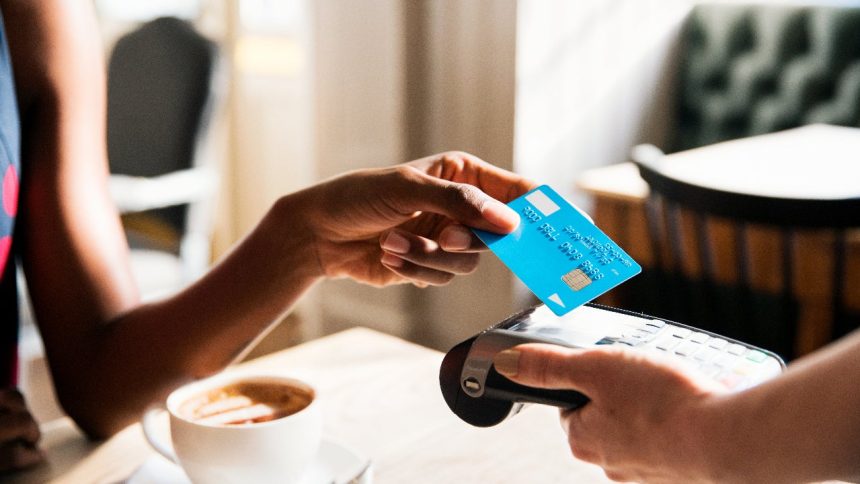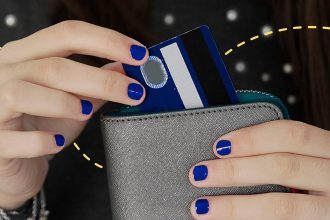Key takeaways
- RFID credit cards are growing in popularity and have already been adopted by major credit card issuers.
- These cards use radio frequencies to allow the cardholder to pay at terminals by tapping their card on a card reader as opposed to swiping or inserting their card.
- RFID credit cards are considered safe to use, and credit card fraud using RFID readers is rare and difficult to do.
Radio-frequency identification (RFID) credit cards have a type of contactless card technology that allows you to make your payment by simply tapping your card at the payment terminal.
While these types of cards had already begun replacing traditional cards without this technology for many years, the demand for them grew quickly during the COVID-19 pandemic as people were looking for ways to minimize contact with surfaces.
Most major issuers have integrated this technology into all of their new cards, but like any credit card you carry, you should still take precautions to ensure that your card is safe from identity thieves and fraudsters. But if you’re wondering how safe RFID credit card technology is in particular, you’re in for some good news. Before we get into the safety aspect, however, let’s start with understanding how an RFID card actually works.
What is an RFID credit card and how does it work?
An RFID credit card is equipped with radio frequency identification technology. This allows your credit card to communicate with a payment terminal using a radio frequency instead of a magnetic strip.
RFID technology allows you to simply tap or wave your credit card near a card reader or ATM. Using this technology to make purchases gives you the ability to complete transactions within seconds. Plus, your card never has to leave your hand, minimizing contact with the card terminal and the likelihood of leaving your card in the reader.
How to determine if your card is RFID-enabled
While RFID technology is becoming the norm for new credit cards, not all cards have been updated with the technology. Older cards that might not have hit their expiration date yet, for example, might still be missing this technology. If you’re not sure whether your card is RFID enabled, you can easily check by taking a look at the card.
RFID-enabled cards have a symbol on the front or back of the card that looks like a Wi-Fi icon turned on its side. This symbol is meant to represent the radio frequency used by the card to make it contactless.
If your card has that symbol, you should be able to make purchases with a wave or a tap of your card. To be sure, you can test it the next time you go to a shop, ATM or gas station pump. When you’re at the payment terminal, look for the contactless symbol on the card reader, which looks the same as the symbol on your card. Then, simply tap your card on the payment terminal to complete your transaction.
How secure are RFID credit cards?
RFID credit cards are considered to be as safe as EMV chip cards, and data theft concerning RFID cards is uncommon. This is because of how these cards transmit information and what information is shared.
Unlike traditional credit cards, RFID cards use one-time codes to complete each transaction. Every time you use your RFID card, a new code is created, thus making it more difficult for your information to be compromised. However, just because theft using this technology is uncommon doesn’t mean it’s impossible to do.
Do you need RFID-blocking protection?
Because RFID credit cards work via radio frequencies, some thieves have begun targeting these credit cards by using RFID readers. These readers could potentially pick up your card information without your knowledge by getting close enough to your card to pick up on the radio frequency. For this reason, there are quite a few products on the market, such as sleeves and wallets, that claim to have RFID protection.
However, these products are not necessary to keep your RFID credit cards safe. For a person to compromise your card information, they would have to get very close to you — typically a few inches max — with an RFID reader that could pick up the signal. That signal is incredibly weak, so there would have to be practically no barriers between the card and card reader. This means that if you already have your card in a wallet or bag, it’s likely protected enough from the range of an RFID reader.
Plus, even if a reader were able to pick up the signal, it could run into issues with the other contactless cards in your wallet also sending out signals. These readers are typically unable to scan multiple cards at once, so it could have trouble singling out one card to read anyway. On top of that, because of the one-time codes that we mentioned earlier, it’s unlikely that a thief could store your card information to use over and over like they could when they have your physical credit card.
While it is technically possible for a thief to find a way to skim your RFID card, they would have to work quite hard to do so. If you do find yourself targeted for credit card fraud and identity theft, regardless of how it happens, report the theft immediately. The faster you do so, the more likely that your bank or card issuer will cover the fraudulent charges under their liability policy.
Tips for preventing credit card theft
RFID credit cards are some of the most secure credit cards at our disposal, but it’s still good to take precautions as with any other credit card. Here are some tips that can help you get started:
- Set up mobile alerts for all of your accounts. Mobile alerts will give you a notification any time your card is used, allowing you to immediately identify suspicious charges.
- Make sure you have a strong password for your online accounts. If you’re worried about losing your password or forgetting it, you can take advantage of a password management app like Dashlane or LastPass. Just avoid saving your password on websites via your browser if possible.
- Take the time to review your credit card statements and credit report routinely. These tools document activity on your accounts and give you a clear picture of how your card is being used and what you’re being charged for, so it’s a good idea to review them each week to catch early signs of fraud. You can get free weekly credit reports by using the government-authorized website AnnualCreditReport.com.
The bottom line
RFID credit cards allow you to pay with a tap, rather than inserting or swiping your card. Special RFID-blocking wallets and sleeves, despite their popularity, generally aren’t necessary for security because the technology requires an obstruction-free environment and extremely close proximity to the card that’s being targeted. In other words, most materials — such as a regular wallet, a purse, or a pocket — will prevent the RFID technology from working, making it tough for a scammer to tap your card without your knowledge.
If you don’t currently have a card with this technology and want it, consider contacting your card issuer. They can likely send you a replacement card with this feature. Most of today’s top credit cards will already have this feature included, but you can always reach out to the issuer to double check before you apply.
Read the full article here














